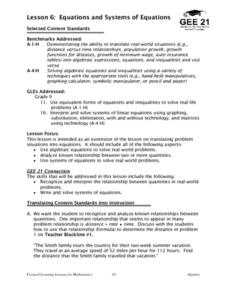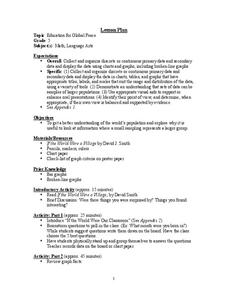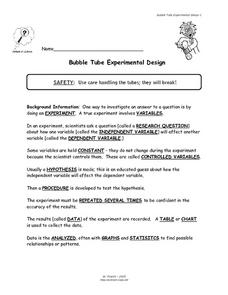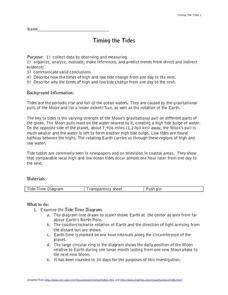Curated OER
Making Careful Observations
Second graders view pictures of items they recognize, items they don't recognize, and write observations they see. For this observations lesson plan, 2nd graders discuss how they use their observations.
Curated OER
Confucius and Confucianism
Students explore Confucius and his influence on the development o China. They contrast and compare Confucianism to Western philosophy. Classmates observe a video of the biography of Confucius. They video conference with students in...
Curated OER
Equations and Systems of Equations
Students practice using algebra to be applied to real world situational problems. The key concepts of translation of language to algebraic expressions is covered. They also look in depth at relationships between different quantities.
Curated OER
Cubic Unit Models
Fourth graders find the volume of solids. In groups, 4th graders use spinners to determine the dimensions of solids. They construct the shapes, creating a model of the figure Students count the cubes in the model to determine the...
Curated OER
Calendar Math
Students count and name the numbers and days on the calendar in order to determine the date. They identify the month and the entire date, and determine the pattern shown on the calendar markers. Students then calculate how many days...
Curated OER
The Dentist
Students read a short story about visiting a dentist. Then they use toothbrushes in order to demonstrate the correct way to brush teeth. Students use the internet to investigate how some foods are healthier for teeth than others. Then...
Curated OER
EGG-cellent POLYMER PACKAGING DESIGN
Students investigate the concept of a polymer using an experimental design of protecting an egg in a bookbag. They test the properties of polymers and form an educated solution to the proposed problem. Then they describe the steps used...
Curated OER
Help Wanted: A Lighting Engineer For Popular Rock Group
Students are assigned to groups, and determine each member's role in the group. They will design an experiment to determine a way to produce the three primary and five secondary colors. Students discuss color and mood. They listen to a...
Curated OER
Poster Assignment: Sports Chemistry
Tenth graders distinguish between chemical and physical properties and changes in matter when given specific examples. They view a video of sports activities. Students chose their favorite sport and design an experiment to improve sports...
Curated OER
Bird Beak Adaptation Lab
Middle schoolers investigate bird beaks to determine which physical adaptations are necessary based on the types of food the birds eat. They participate in a lab by visiting multiple stations to determine which beaks are most efficient,...
Curated OER
How to Avoid Having a Bad Day
Second graders explore cause and effect. They read Alexander and the Terrible, Horrible, No Good, Very Bad Day. They discuss their own experiences with bad days. Students identify the causes and effects in the book. They write a letter...
Curated OER
Teaching the Five Themes of Geography Through Picture Books
Read the story Make Way for Ducklings and introduce little ones to the five themes of geography. Reread the story, while displaying transparencies to reinforce the five themes. In groups, learners view pictures and identify the themes on...
Curated OER
Graphing
Fifth graders practice using math graphs. In this graphing instructional activity, 5th graders work in groups to develop a topic of their own to represent as a graph. Students collect data and construct a graph for the instructional...
Curated OER
Dividing
Fifth graders explore the inverse proportional relationship and direct proportional relationship. They complete division chart showing the inverse relationship and direct relationship. Students are shown that division problems can be...
Curated OER
Mathematics Within: Bar And Pie Graphs
Students compare and contrast the use of bar and pie graphs with the same data. They create a data set by surveying all students in the class using sticky notes to make a table on the board. Then, each student creates a bar and pie graph...
Curated OER
Counting
Second graders comprehend how to use two different kinds of graphs. They complete a worksheet with the help of the teacher and a bag of jellybeans and then another worksheet without the direction of the teacher. Students listen as the...
Curated OER
Muscles
In this muscles worksheet, learners describe characteristics of the three types of muscle and the function of each. Then they describe the gross and microscopic anatomy of skeletal muscle. Students also describe the steps that occur in a...
Curated OER
Education for Global Peace
Fifth graders construct data graphs based upon sets of data. In this graphing instructional activity, 5th graders read the text If the World Were a Village and discuss how types of graphs accurately represent a large population. Students...
Curated OER
Bubble Tube Experimental Design
Middle schoolers study what an experiment is comprised of and how to be successful when doing an experiment. In this experimental lesson students design their own experimental investigation and answer questions.
Curated OER
Timing the Tides
Students collect data and describe how and why the high and low tides change from day to day. In exploring tides activity students study tides by taking notes, recording data and analyzing their findings.
Curated OER
Olympic Line Graphs
Sixth graders examine how to make line graphs. In this Olympic line graph lesson students make line graphs and search the given Internet sites to find data on their summer Olympic Game.
Curated OER
Drawing From Nature
Students observe similarities and differences of natural objects. In this observation lesson plan, students use a magnifying glass to identify the details of objects.
Curated OER
Measuring & Graphing Motion
Fifth graders study how to measure distance. In this graphing motion lesson students complete a lab activity that shows them on the computer how to make graphs.
Curated OER
Open-Ended Scientific Method Lab
Learners inspect a given problem and come up with a hypothesis. In this investigative lesson students come up with a hypothesis for a problem, test each hypothesis and evaluate how successful each one was.

























